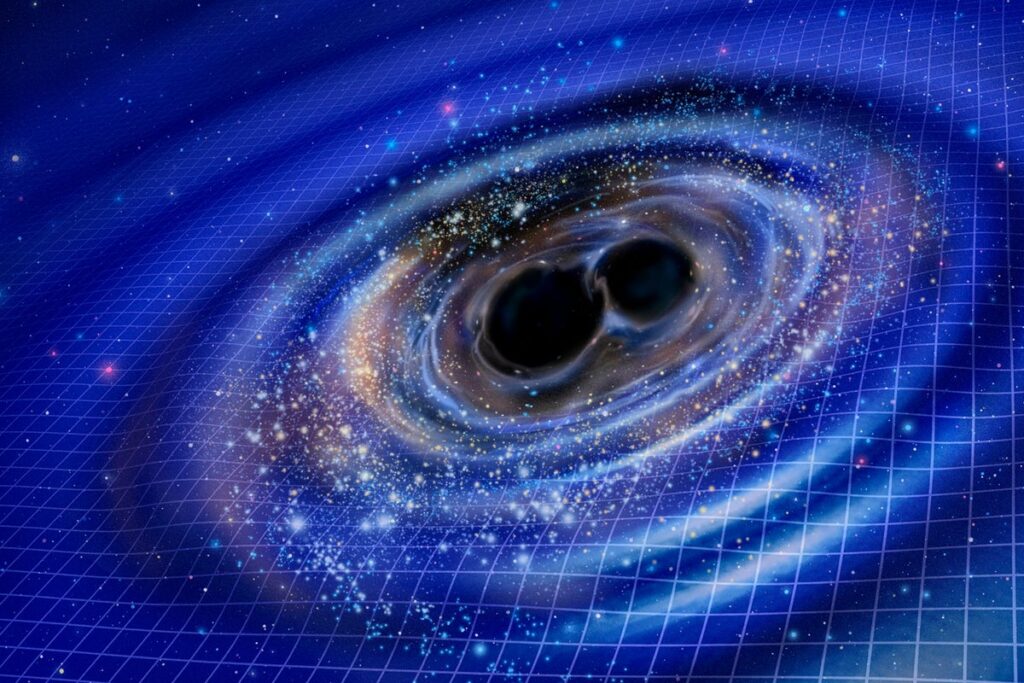Physicists have detected the biggest ever merger of colliding black holes. The discovery has major implications for researchers’ understanding of how such bodies grow in the Universe.
“It’s super exciting,” says Priyamvada Natarajan, a theoretical astrophysicist at Yale University in New Haven, Connecticut, who was not involved in the research. The merger was between black holes with masses too big for physicists to easily explain. “We’re seeing these forbidden high-mass black holes,” she says.
The discovery was made by the Laser Interferometer Gravitational-Wave Observatory (LIGO), a facility involving two detectors in the United States. It comes at a time when US funding for gravitational-wave detection faces devastating cuts. The results, released as a preprint on the arXiv server1, were presented at the GR-Amaldi gravitational-waves meeting in Glasgow, UK, on 14 July.
On supporting science journalism
If you’re enjoying this article, consider supporting our award-winning journalism by subscribing. By purchasing a subscription you are helping to ensure the future of impactful stories about the discoveries and ideas shaping our world today.
Forbidden mass
LIGO detects gravitational waves by firing lasers down long, L-shaped arms. Minuscule changes in arm length reveal the passage of gravitational waves through the planet. The waves are ripples in space-time, caused by massive bodies accelerating, such as when two inspiralling black holes or neutron stars merge.
Hundreds of these mergers have been observed using gravitational waves since LIGO’s first detection in 2015. But this latest detection, made in November 2023, is the biggest yet. By modelling the signal detected by LIGO, scientists have calculated that the event, dubbed GW231123, was caused by two black holes with masses of about 100 and 140 times that of the Sun merging to form a final black hole weighing in at some 225 solar masses.
“It’s the most massive [merger] so far,” says Mark Hannam, a physicist at Cardiff University, UK, and part of the LVK Collaboration, a wider network of gravitational-wave detectors that encompasses LIGO, Virgo in Italy and KAGRA in Japan. It’s “about 50% more than the previous record holder”, he says.
Most of the events captured by LIGO involve stellar mass black holes — those ranging from a few to 100 times the mass of the Sun — which are thought to form when massive stars end their lives as supernovae. However, the two black holes involved in GW231123 fall in or near a predicted range, of 60–130 solar masses, at which this process isn’t expected to work, with theories instead predicting that the stars should be blown apart. “So they probably didn’t form by this normal mechanism,” says Hannam.
Instead, the two black holes probably formed from earlier merger events — hierarchical mergers of massive bodies that led to the event detected by LIGO, which is estimated to have happened 0.7 to 4.1 billion parsecs away (2.3—13.4 billion light years).
It’s like “four grandparents merging into two parents merging into one baby black hole”, says Alan Weinstein, a physicist at the California Institute of Technology in Pasadena and also part of the LVK Collaboration.
Models of the black holes also suggest that they were spinning exceedingly fast — about 40 times per second, which is near the limit of what Einstein’s general theory of relativity predicts black holes can reach while remaining stable. “They’re spinning very close to the maximal spin allowable,” says Weinstein.
Both the spin and the mass could provide clues to how black holes grow in the Universe. One of the biggest questions in astronomy is how the largest black holes, the supermassive black holes found at the centres of galaxies such as the Milky Way, grew in the early cosmos.
Although there is plenty of evidence for the existence of stellar mass black holes and supermassive black holes — those of more than a million solar masses — intermediate mass black holes in the range of 100 to 100,000 solar masses have been harder to find. “We don’t see them,” says Natarajan.
The latest detection might tell us that “these intermediate-mass black holes of several hundred solar masses play a role in the evolution of galaxies”, says Hannam, perhaps through hierarchical mergers, which could increase the spin speed, as well as the mass, of the resulting black holes. “Little by little, we’re building up a list of the kind of black holes that are out there,” he says.
Cuts ahead
That growth in knowledge could be hampered by the administration of US President Donald Trump and its proposed cuts to the US National Science Foundation, which runs LIGO. Under the proposal, one of LIGO’s two gravitational-wave observatories would be shut down.
At the time of this detection in November 2023, Virgo and KAGRA were not operational. Without two detectors, scientists would not have been sure that they had made a real detection of two merging black holes, says Hannam. “Because we had two detectors, we saw the same blip at the same time,” he says.
The closure of one of the observatories would be “catastrophic”, says Natarajan. “This discovery would not be possible if one arm was turned off.”
Planned upgrades to LIGO in the coming years, and the addition of new detectors around the world, including one in India, could greatly increase physicists’ capabilities in gravitational-wave research, an area of astronomy that is still in its infancy.
“We’re going to be seeing thousands of black holes in the next few years,” says Hannam. “There’s this huge investment that’s been done, and it’s only just beginning to pay off.”
This article is reproduced with permission and was first published on July 15, 2025.


